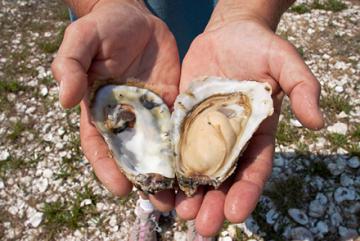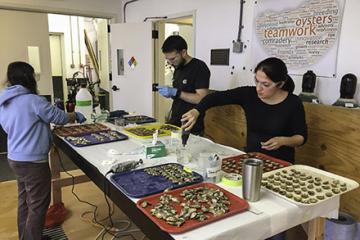ARS Joins Effort to Boost Oyster Production

Oysters and other shellfish are the top U.S. marine aquaculture products. (Photo by USDA-NRCS., D3904-1)
USDA’s Agricultural Research Service (ARS) has joined a team of shellfish geneticists whose task is to advance oyster breeding to generate better performing oysters for farmers and boost oyster production along the U.S. Eastern Seaboard.
Dina Proestou, a research geneticist with ARS’ National Cold Water Marine Aquaculture Center in Kingston, RI, is part of a consortium of 14 shellfish geneticists from 12 universities and government organizations that is developing new methods to accelerate selective breeding and expand it to new regions along the East Coast.
Oysters are critical to many U.S. waterways because, as filter feeders, they help improve water quality as they filter their food from the water.
Proestou said that one of the key challenges for genetic improvement in oysters at large is they are grown across extremely diverse environments with respect to temperature, salinity, food availability, and disease exposure. “Previous research showed that selectively-bred oysters do not perform equally well across growing environments; they grow best at their native sites,” she said. “For example, oysters bred in Maine do not survive in Virginia. This finding has important implications for breeding oysters to support the entire East Coast industry.”
From her lab at the University of Rhode Island (URI), Proestou is performing experiments and genomic analyses to determine susceptibility and resistance to Dermo, a parasite responsible for the massive die-off of oysters since the 1940s. She has also been working with other researchers to sequence the eastern oyster genome and develop tools they can apply to breeding programs.

ARS geneticist Dina Proestou and colleagues from the Virginia Institute of Marine Science prepare oysters for a study of Dermo disease. (Photo by Kathryn Markey Lundgren, D3915-1)
The consortium’s goal is to accelerate and/or increase the precision of the traditional breeding process by incorporating genomic information. “We are hoping to associate traits like fast growth, disease resistance, and low salinity tolerance with specific regions of the genome,” Proestou said. “Once we have that information, we can breed oysters that possess these features in less time and with greater precision.”
It’s important to note that the scientists are not artificially changing the oyster’s DNA sequence; and they are not introducing foreign DNA into oysters or manipulating the number of its chromosomes.
In order to make the links between genotype (the genetic composition of an organism) and phenotype (the organism’s physical appearance), scientists need to understand the oyster’s genome sequence and locate the genetic variations – single nucleotide polymorphisms (SNPs) – that control the traits of interest.
Proestou was part of a team that recently released a chromosome-level genome assembly for the eastern oyster, a first for bivalve mollusks. The group also sequenced 90 additional oysters collected from the East Coast and the Gulf of Mexico to capture as many SNPs in the species as possible.
Oyster breeding can help bring new life to some of our key waterways. For example, the National Oceanic and Atmospheric Administration estimates that oysters were once able to filter all the water in the Chesapeake Bay in about a week; it now takes about a year to filter the same amount of water. The entire ecosystem could see a boost with an increase in healthier oysters, as would the livelihood of watermen and the oyster industry in general. In 2013-2014 (the latest year of data from both states), the dockside value of oysters in Maryland and Virginia was $15.7 million and $28 million, respectively. – By Scott Elliott, ARS Office of Communications.

